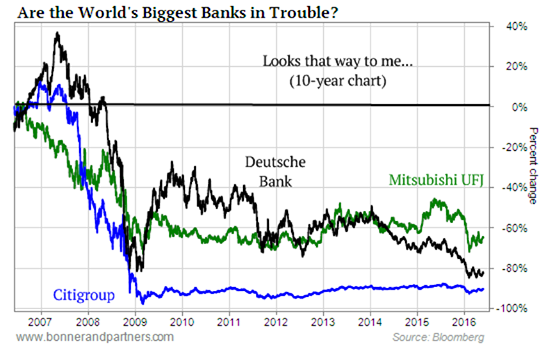
As you go about your everyday life, it’s easy to forget how big the economic problems we face really are… and how desperate our political leaders have become to safeguard the existing system.
That’s because of human psychology. It’s called the “normalcy bias.” It explains why, if you don’t heat up the water too fast, the “frog” never jumps out of the pot before it starts to boil. People (the frogs) have a hard time believing that tomorrow won’t be a lot like today. It can be almost impossible to open your mind enough to think about how the world might look a year from now… or five years from now… if there’s a serious economic crisis.
That’s what I believe is going to happen. I’ve written about the problems I see in the world economy over the past year or so. I’ve described the potential for $1.7 trillion in corporate-bond defaults, a credit crisis I’ve said would be “the greatest legal transfer of wealth in history.”
If you don’t agree with me, then all of these warnings might make me sound like a crazy person. I probably sound crazy to a lot of people… at first. But I put the bug in their ear. Slowly, they start seeing what’s happening. It takes time. But I believe, more and more, you’re starting to see these things for yourself. It’s getting harder to believe that everything is fine.
Meanwhile, I don’t advocate selling everything you own and moving to New Zealand. Nor do I even recommend selling all of your stocks. I am telling you: Keep your head up and your mind open to the risks. What’s about to happen isn’t just a normal market correction or even a bad bear market. What’s about to happen is a once-in-a-century debt-default cycle that could destroy the world’s existing paper-money standard.
Think that’s nuts? OK, maybe it is. But take a minute and look at this chart…

This chart isn’t hard to figure out. It simply compares the largest, most systematically important banks in the world: Mitsubishi UFJ (MTU), Deutsche Bank (DB), and Citigroup (C). Their share prices are down 66%, 80%, and 90% over the past 10 years.
How is that possible?
I’d like for you to ask yourself two simple questions: First, if you believe that everything in the world’s economy is basically fine and operating normally… how could the three most important banks in the world all be falling apart? Ask a reasonably well-read and knowledgeable person – like your broker, or the friend you always talk with about investments – what the 10-year return has been on the three largest banks in free-market capitalism. I guarantee they won’t come anywhere close to the correct answer.
That’s normalcy bias in action. People constantly disregard any facts or data points that don’t match their underlying assumptions, especially when those data points would disrupt a long-held belief or worldview. Let me say this as plainly as I can: If our global financial system were working normally, the returns on these major, immensely important piles of capital would at least be positive.
Here’s the second question I want you to think about carefully: How far will these banks have to fall before you think seriously about taking all of your savings out of the banking system? If these banks fail, the system will fail. And how much faster will you make the decision to pull your cash if these banks begin charging you to hold your cash in their bankrupt vaults?
Now… let me back up for a second.
The reason these banks have struggled for an entire decade isn’t hard to understand. You don’t need to be an economist. If you have been alive for the last 20 years, you know what happened…
A tremendous amount of credit was created out of thin air around the world. You can measure it in plenty of ways: total debt to GDP, the size of financial earnings as a percentage of GDP, debt service as a percentage of household income. I could bury you in numbers… but they all mean the same thing.
For an entire generation, most people in the world’s major, wealthiest economies consumed far more than they produced, resulting in a debt bubble of mind-boggling, epic proportions.
This process of unlimited credit creation is hitting the wall of economic reality. Wages haven’t grown. Productivity hasn’t grown as fast. And various economic tricks to extend even more credit – like increasing international trade, manipulating currencies, and printing money – are running out of steam. Thus, this massive, global bubble is beginning to deflate. Before that can happen, though… credit has to stop expanding. That’ll be the first sign that the real collapse is happening.
As you’ll recall, a lot of the credit created in our economy relied on ever-increasing housing prices. Fannie Mae and Freddie Mac were the primary guarantors of the bubble in the U.S. – a total of $5 trillion in credit was created in about a decade on just two balance sheets.
Lately, though, credit has only been expanding in far less secure ways. Globally, credit has been expanding by lending to corrupt emerging markets (like China, Brazil, and Russia). In the U.S., credit has been piled onto the backs of college students and subprime auto lending (nuts!). Sovereign debt around the world has technically been expanding, too… But as you know, that’s a rigged game where the national treasuries offer bonds and the central banks buy them with newly printed money.
And so… the world economy has moved from making loans on good collateral (sound residential mortgages) to lending billions to corrupt dictatorships, unemployed college students, and subprime auto-buyers. Oh, we’re also growing credit by printing money. No wonder those major banks are falling apart. I’d be willing to bet a huge amount of money that the folks auditing the banks’ loan books don’t keep their cash in those banks.
In various ways, all of these bad loans end up on the balance sheets of the world’s biggest banks. The means of transmission are varied: The loans are securitized, they’re sold, they’re “swapped.” These loans and their underlying collateral end up in a myriad of different derivative products. In short, they’re everywhere. These loans are at the heart of the financial system we use to drive the world economy. And today, they’ve transformed the global economy into a mountain of hugely inflated value… a giant pile of steaming, worthless garbage.
So what happens when suddenly, for no discernable reason at all, everyone decides to stop pretending otherwise?
When that happens, the authorities will have three choices. They can…
- Inflate away the bad debt by devaluing the currency and propping up the banking system with newly printed money and trade surpluses. That’s the International Monetary Fund’s playbook. It’s what Japan has tried to do for 30 years. And it seems like that’s what America and Europe are going to try now, too. Or…
- Write off the bad loans, shut down the bad banks, and suffer a severe (but short) crisis. That’s the sound-money option. (Nobody does that anymore, because depositors in the bad banks would lose everything… and they vote.) Or…
- Simply repudiate a lot of the debt and stiff the creditors, like Russia did in 1998 and Iceland did in 2008. (That option works best if you have foreign creditors… like Argentina did in 2002.)
Nobody knows what’s going to happen when most of the world’s wealthiest and largest economies try option No. 1 at the same time. But let me hazard a guess: The outcome isn’t going to be good for people who saved all of their money in paper currencies.
And that brings us to gold. As you may know, gold had its best quarter since 1986. The metal’s spot price was up more than 16% in the first quarter of 2016. Yes, this could be simply a random price move. But I don’t think so.
My friend Dr. Steve Sjuggerud has done careful studies of what moves of this magnitude mean in the market for gold. His research analyst Brett Eversole published the results of one of their most recent studies in the March 8 DailyWealth. Their work shows that given gold’s recent price moves, they would expect gold to move 19% more over the next 12 months.
Keep in mind, that’s based on the last 40 years of trading during normal market conditions… not a period that features a global financial crisis like the kind I expect. So it’s a good time to buy gold, even if the crisis we expect doesn’t materialize.
Gold does best when real interest rates are negative. The reason is easy to understand: Gold is the ultimate hedge against the loss of purchasing power in paper currencies. If governments can’t offer a real rate of return for holding their bonds, then investors aren’t being protected against inflation. And as a result, they flee to gold.
Negative interest rates would greatly exacerbate this logical market preference… and that’s exactly why gold has been soaring lately. As Steve explained in the March 15 DailyWealth…
When both gold and paper money pay zero-percent interest, investors prefer gold over paper. Right now, paper money is paying you zero [or even less]… It’s time for people to own gold.
We now stand on the precipice of one of the biggest bull markets in gold the world may ever see.
I personally believe the price of gold could be more than 10 times what it is today. And certain gold stocks could go up 10, 20, or even 50 times their current prices.
Regards,
Porter Stansberry
Founder, Stansberry Research
For an offer from Stansberry Gold Investor, click here
related from Larry Edelson:












